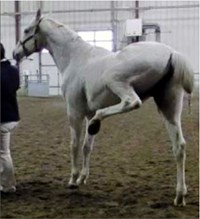
In 2008, University of Minnesota researcher Stephanie Valberg, DVM, PhD, began gathering data on the movement disorder known as shivers by asking owners of affected horses to fill out an online survey and send in videos of their horses. Eventually, she would have 300 respondents from around the world and 70 videos to examine for clues to this devastating condition. These videos ultimately lead Valberg’s team to discovering the underlying cause of the condition—a degenerative lesion in the cerebellum of affected horses. Here are three videos, and horses, who contributed to this groundbreaking discovery.
This is Harvey, a bay Warmblood who initially only showed signs of intermittent hyperflexion in one hind limb. After he was restricted to a stall for several weeks because of an illness, his signs became more pronounced and he hyperflexed when turning tightly and when backing. Over a couple of years, Harvey had progressively more difficulty backing and holding up his hind feet for cleaning. Eventually he started showing signs of hyperflexion when walking forward, turning tightly and backing up as shown in this video.
This chestnut Warmblood gelding began showing signs of shivers at a young age. Hyperflexion made it difficult for him to back up or and holding up a hind leg when his hooves were picked. Often, when asked to pick up one hind limb he would pick up the opposite one. When the leg was flexed it could remain in hyperflexion. His distress is evident in the video; note the way he starts to move his head and hindquarters even before his handler asks him to pick up the hind limb. His reluctance to flex is likely due to anxiety over not being able to do what he knows the handler wants him to do.
This is Stanley, the horse profiled in “The Mystery of Shivers,” (EQUUS 448, January 2015). He was in a very advanced stage of shivers at the point this video was taken. His limbs get stuck in hyperflexion intermittently at a walk, consistently when backing and occasionally when turning. At times, he suspends both hind legs in the air before he is able to release one to catch himself from falling. Unlike in stringhalt, with this condition the leg is flexed and pulled away from the body. With stringhalt, the leg is flexed forward, the limb is not pulled outward and the hoof is under the belly.








